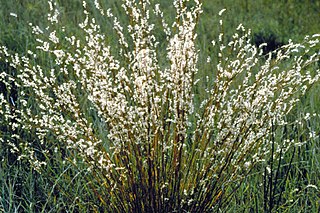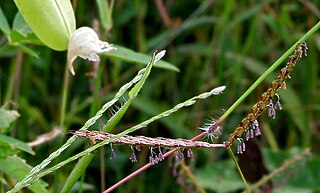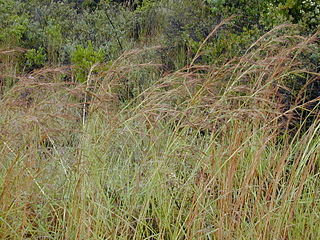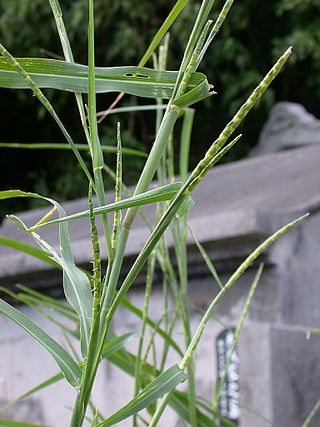
Saccharum is a genus of tall perennial plants of the broomsedge tribe within the grass family.

The Andropogoneae, sometimes called the sorghum tribe, are a large tribe of grasses (family Poaceae) with roughly 1,200 species in 90 genera, mainly distributed in tropical and subtropical areas. They include such important crops as maize (corn), sugarcane, and sorghum. All species in this tribe use C4 carbon fixation, which makes them competitive under warm, high-light conditions.

Digitaria is a genus of plants in the grass family native to tropical and warm temperate regions but can occur in tropical, subtropical, and cooler temperate regions as well. Common names include crabgrass, finger-grass, and fonio. They are slender monocotyledonous annual and perennial lawn, pasture, and forage plants; some are often considered lawn pests. Digitus is the Latin word for "finger", and they are distinguished by the long, finger-like inflorescences they produce.

Cenchrus is a widespread genus of plants in the grass family. Its species are native to many countries in Asia, Africa, Australia, the Americas, and various oceanic islands.

Andropogon is a widespread genus of plants in the grass family, native to much of Asia, Africa, and the Americas, as well as Southern Europe and various oceanic islands.

Bothriochloa is a common and widespread genus of plants in the grass family native to many countries on all inhabited continents and many islands. They are often called beardgrass, bluegrass or bluestem. Some species are invasive in areas where they have been introduced.

Ischaemum is a genus in the tribe Andropogoneae, belonging to the grass family, widespread in tropical and semitropical regions in many countries. Many species are known commonly as murainagrass.

Enneapogon is a cosmopolitan genus of plants in the grass family.

Themeda is a genus of plants in the grass family native to Asia, Africa, Australia, and Papuasia. There are about 18 to 26 species, many of which are native to Southeast Asia.

Hyparrhenia is a genus of grasses. Many species are known commonly as thatching grass.

Apluda is a genus of plants in the grass family native to Asia and to various islands in the Indian and Pacific Oceans.

Coelorachis is a genus of plants in the grass family, widespread across much of Asia, Africa, Australia and the Americas.

Schizachyrium is a widespread genus of plants in the grass family. The name is derived from the Ancient Greek words σχίζειν, meaning "to split," and ἄχυρον, meaning "chaff." It refers to either the glume or the toothed lemmas.

Spodiopogon is a genus of Asian plants in the grass family.
Thelepogon is a genus of Asian, African, and Australian plants in the grass family.

Tristachya is a genus of African and Latin American plants in tribe Tristachyideae within the grass family.
Parahyparrhenia is a genus of Afro-Asian plants in the grass family. Globally, the genus comprises seven species. Two species are known to occur in India, where they are narrow endemic. The species show disjunct distribution in Africa and Asia. Parahyparrhenia bellariensis (Hack.) Clayton an extremely rare grass which was presumed extinct was rediscovered after the span of 184 years from its type locality in the state of Andhra Pradesh, South India by Mr. Shahid Nawaz, an agrostologist at the Blatter Herbarium. Following its rediscovery, it has been classified as Critically Endangered (CR) by following the guidelines of IUCN Criteria and Category.

Hackelochloa is a genus of Asian and African plants in the grass family.

Rhytachne is a genus of plants in the grass family. They grow principally in wet savannahs in Africa and the Americas. More specifically, they tend to prefer transitional zones between marshes and drier upland savannahs. In the Americas, the genus can be found from southern Mexico and Cuba south to northern Argentina, while in Africa it is present in Sub-Saharan Africa, including in Madagascar. Twelve species are included, of which nine are African, two are American, and one, Rhytachne subgibbosa, is found on both continents. The genus is closely related to Coelorachis.

Rottboellia is a genus of African, Asian, and Australian plants in the grass family.


















